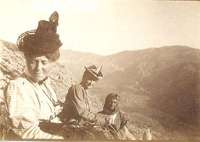Blanche Wheeler Williams
| Blanche Wheeler Williams | |
|---|---|
 | |
| Born |
January 9, 1870 Concord, Massachusetts |
| Died |
December 9, 1936 (aged 66) Cambridge, Massachusetts |
| Alma mater | Smith College |
| Occupation | Archaeologist |
| Known for | Discoveries in Isthmus of Hierapetra and at Gournia |
Blanche Wheeler Williams (January 9, 1870 – December 9, 1936) was an archaeologist and teacher best known for her work in the Isthmus of Hierapetra and her discoveries at Gournia with colleague Harriet Boyd Hawes. She was trained at Smith College and worked as a teacher at her aunt's preparatory school until her Cretan archaeological digs in 1900 and 1901. Williams was married in 1904 and did not return to the field after contributing to a 1908 publication, though she wrote a biography of her aunt and helped with her husband's travel book.
Early life
Williams was born Blanche Emily Wheeler[2] on January 9, 1870 in Concord, Massachusetts.[3] Her family history stretches back to the early New England colonies, including the Plymouth Colony Pilgrims.[3] She was closely connected with her grandmother in her youth, who introduced Williams to prominent intellectuals including Ralph Waldo Emerson, Henry David Thoreau, and Amos Bronson Alcott.[3] Williams graduated from Smith College in 1892, where she studied ancient art, archaeology, Greek, Latin, drawing, and painting.[3] She befriended Harriet Boyd there, who became a close friend and colleague.[3]
Career
After graduation, Williams taught Latin, Greek, and English at her aunt's Mary C. Wheeler School, a Providence, Rhode Island preparatory school, until her 1904 marriage.[3] She conducted tours of Europe with her students.[3] Williams became disenchanted with teaching and took a one-year sabbatical in 1898, where she visited Greece and Italy with Boyd and fellow Smith alumna Mary Waring.[3]
She went to Crete's Isthmus of Hierapetra in 1900 and found an undisturbed Bronze Age beehive tomb in Kavousi, which she presented at the Philadelphia Archaeological Institute of America's December meeting.[3] Sara Yorke Stevenson, the secretary of the American Exploration Society, was impressed by William's talk, discovery, and presence.[3] The Society would fund her 1901 and 1903 excavations.[3]
In 1901, Williams set out to find a palace to rival those found at Knossos and Phaestos, and left her Kavousi site for Avgo in the east, where she was joined by Boyd.[3] Having the most training, Boyd conducted the fieldwork in test pits and measurements while Williams drew maps and the finds.[3] Their dig was delayed by spring rain and was ultimately uneventful.[3] Following a tip from a local farmer, they began to dig at Gournia and discovered an ancient Minoan complex.[3] They found vase fragments and bronze artifacts before finding architecture like house walls and a paved road.[3] They told the American Exploration Society about the find and their trench workforce grew from 40 to 110 workers in a week, which increased the complexity of the dig directed by Boyd.[3] They found hundreds of artifacts and Williams drew those most important, usually vases.[3] The event was of great importance to Williams, who would frequently write home to her students about the excavation at the forefront of archaeology.[3] It was to be her only year of excavation, as fieldwork was delayed for two years after the first season, and Williams did not return with Boyd.[3] The excavation ended several years later with a total find of more than 60 houses, a central plaza, and a small palace in the town.[3]
Williams married Boston oriental rug importer Emile Francis Williams in 1904.[3] Her husband also collected Chinese porcelain and was an amateur botanist.[3] She maintained correspondence with Boyd, who continued to work in Crete and became a French nurse during World War I.[3] Williams wrote essays on stone vases, seal stones, Minoan religion, and contributed to a 1908 book on the Isthmus of Hierapetra, which was praised by the archaeology community.[3] She no longer wrote about the region, though she wrote a biography of her aunt and helped her husband with his travel book.[3]
Williams died on December 9, 1936 in Cambridge, Massachusetts.[3]
References
- ↑ Joukowsky, Martha Sharp; Lesko, Barbara (eds.). "Blanche Wheeler Williams". Breaking Ground: Women in Old World Archaeology. Brown University. Archived from the original on October 15, 2013. Retrieved October 15, 2013.
- ↑ "Harriet Boyd Hawes Papers, 1888–1967". Five College Archives and Manuscript Collections. Archived from the original on October 15, 2013. Retrieved October 15, 2013.
- 1 2 3 4 5 6 7 8 9 10 11 12 13 14 15 16 17 18 19 20 21 22 23 24 25 26 27 Windham, Anne. "Blanche Wheeler Williams (1870–1936)" (PDF). Breaking Ground: Women in Old World Archaeology. Brown University. Archived (PDF) from the original on October 15, 2013. Retrieved October 15, 2013.
Further reading
- Adams, Amanda (2010). Ladies of the Field: Early Women Archaeologists and Their Search for Adventure. Greystone Books. ISBN 978-1-55365-641-8. Retrieved October 15, 2013.